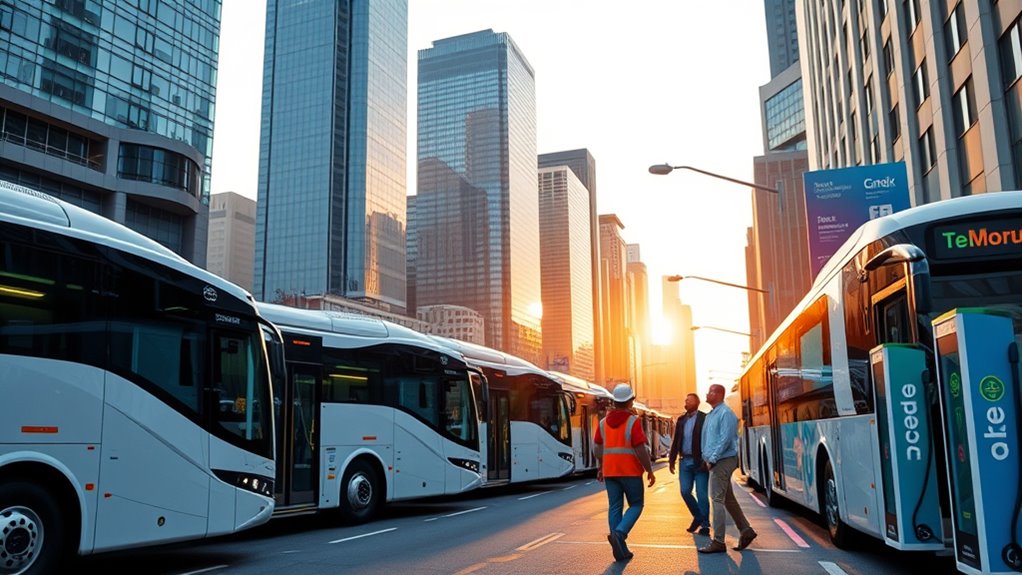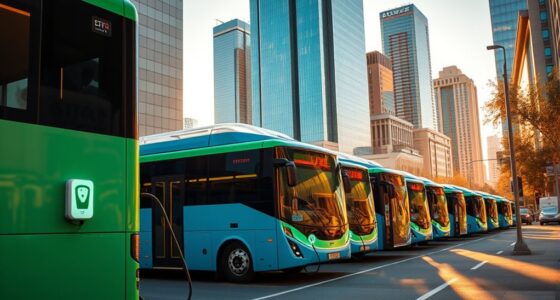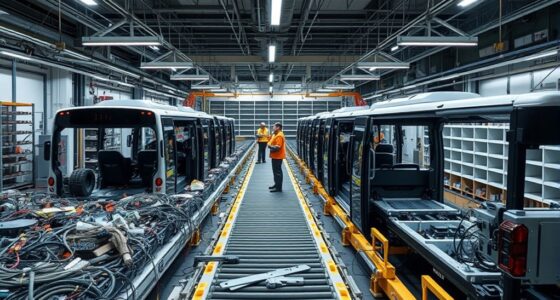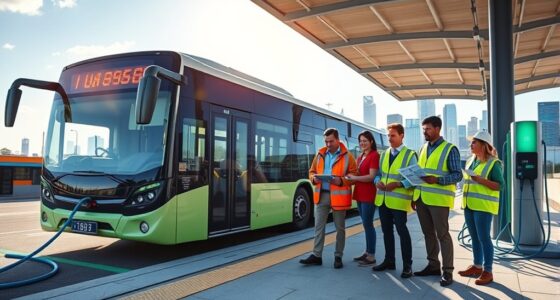Public-private partnerships (PPPs) play a vital role in expanding electric bus deployment by combining public funding, private innovation, and risk-sharing strategies. They help develop charging infrastructure, introduce advanced technologies, and guarantee operational efficiency. Through PPPs, you can leverage financial incentives, innovative solutions, and regulatory support to overcome barriers like high upfront costs and infrastructure gaps. If you’re interested, there’s much more to discover about how these collaborations drive sustainable urban transport.
Key Takeaways
- PPPs facilitate shared funding and risk management, enabling large-scale electric bus infrastructure and fleet deployment.
- They promote innovation through collaboration between public agencies and private sector expertise.
- PPPs streamline procurement, licensing, and regulatory compliance for efficient e-bus project implementation.
- They leverage private capital and financial instruments to reduce government financial burdens.
- PPPs enhance operational efficiency and long-term sustainability through joint planning and stakeholder engagement.
Understanding the Framework of PPPs in E-Bus Projects

To effectively implement electric bus projects through public-private partnerships (PPPs), it’s vital to understand their core framework. First, guarantee your objectives align, focusing on replacing diesel buses with electric fleets to cut emissions.
Establish new entities responsible for procurement, financing, and maintenance, clearly defining their roles.
Proper risk allocation is essential; transfer financial and operational risks to private partners via contracts. Risk management strategies are crucial to address uncertainties related to technology, market fluctuations, and operational challenges.
Effective PPPs allocate financial and operational risks to private partners through clear contractual agreements.
Infrastructure integration involves installing charging stations and upgrading the grid alongside fleet deployment. Additionally, addressing potential technical challenges ensures the reliability and efficiency of the electric bus system.
Maintain regulatory compliance with local and international standards for emissions and service quality.
Different contractual models like unbundled contracts or integrated service agreements help tailor responsibilities.
Incorporate revenue-sharing mechanisms, hybrid financing, and long-term concessions to guarantee financial viability.
Understanding the importance of project financing can help secure necessary funds and ensure sustainability for the deployment.
This structure creates a solid foundation for successful PPP projects in e-bus deployment.
Advantages of Collaborating Through Public-Private Partnerships

Collaborating through public-private partnerships facilitates a range of significant advantages that can accelerate the success of electric bus projects. First, PPPs leverage both public and private funding sources, easing financial burdens and enabling larger-scale deployments. Governments often provide grants and subsidies, while private investors contribute capital and operational expertise, speeding up infrastructure development. Additionally, integrating efficient general ledger coding practices can streamline financial management within these projects, ensuring transparency and accountability. These partnerships also foster innovation by exchanging regulatory insights and technical know-how, leading to advanced e-bus technologies. Additionally, PPPs support environmental sustainability by promoting cleaner transportation and reducing emissions. They improve operational efficiency through shared resources, best practices, and economies of scale, which lower costs and increase vehicle availability. Incorporating sustainable financing methods can further enhance resource mobilization and project viability. Furthermore, implementing effective financial management strategies can enhance the sustainability and long-term success of these initiatives. Effective cost control measures are essential to maintaining the financial health of projects over time. Finally, PPPs stimulate economic growth, create jobs, and attract further investments, strengthening local economies and advancing sustainable urban mobility.
Overcoming Challenges in E-Bus PPP Initiatives
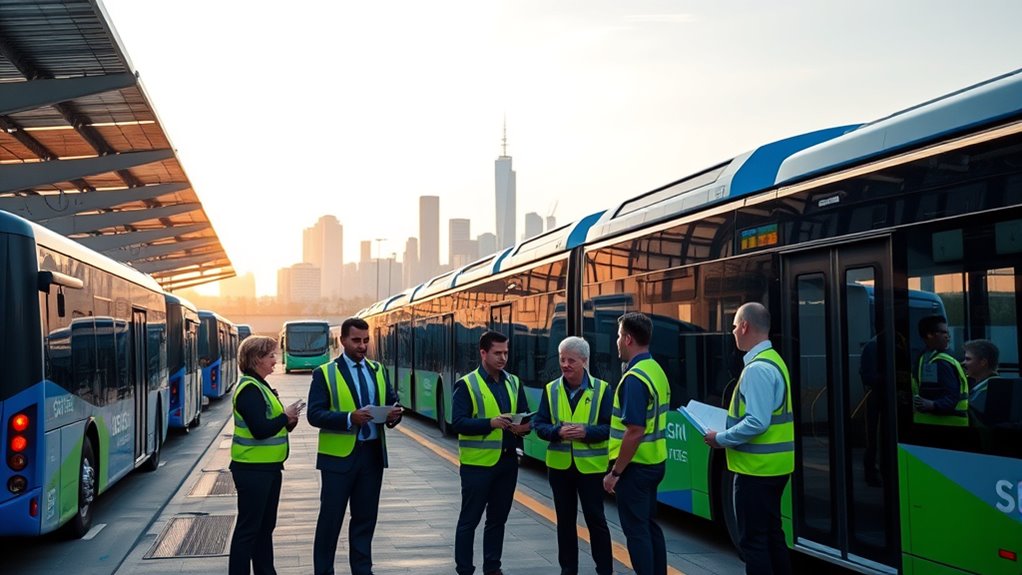
Overcoming challenges in electric bus public-private partnerships requires addressing complex financial, infrastructural, technological, policy, and operational issues. High upfront costs of e-buses and uncertain funding sources can hinder progress. Public-private collaborations help share these costs and risks, making investments more feasible. Infrastructure gaps, like limited charging stations and space constraints, demand joint planning and resource allocation. Technological hurdles, such as battery range variability and charging efficiency, need ongoing innovation and integration efforts. Policy obstacles, including procurement frameworks favoring low initial costs, require reforms and strong governance. Operational challenges, like workforce training and route adjustments, must be managed with strategic planning. Addressing these issues through effective PPPs guarantees smoother adoption, reduces risks, and accelerates the transition to sustainable electric bus systems. Additionally, AI security solutions can support monitoring and optimizing operational efficiency, enhancing overall system resilience.
Notable Examples of Successful E-Bus Deployments via PPPs
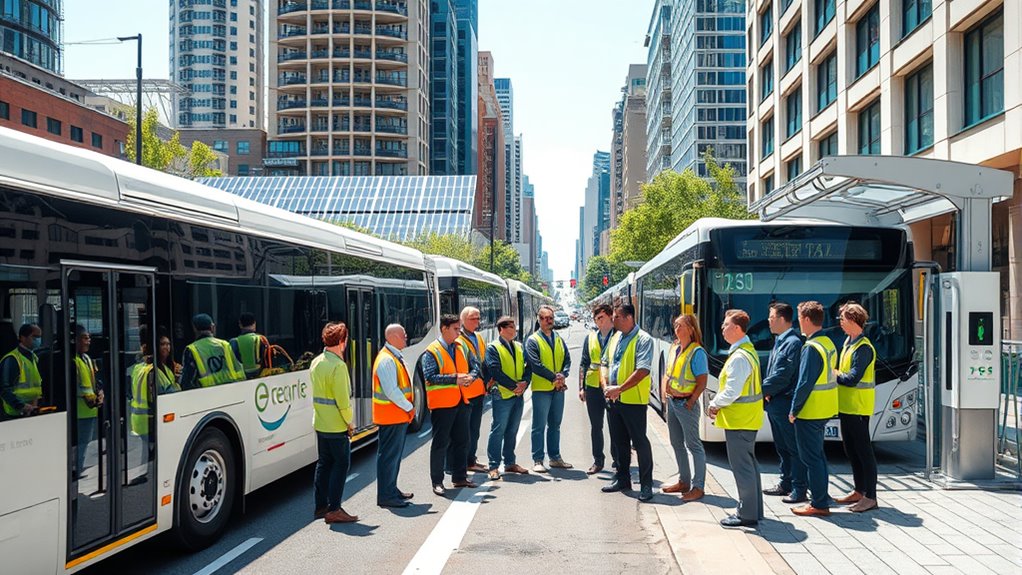
Numerous cities and countries have successfully harnessed public-private partnership models to deploy electric buses at scale, demonstrating the effectiveness of combining public resources with private sector expertise. For instance, Thailand’s ERP Project uses a new-refurbish-finance-bulk-fees model to expand e-bus deployment in Bangkok, reducing emissions. Santiago de Chile launched with small pilots and scaled up with public transport operators, achieving large-scale success. India’s FAME II subsidy scheme, managed by CESL, supports widespread e-bus adoption through financial incentives. Globally, over 25,000 e-buses are projected to be deployed by 2030, with private companies providing manufacturing and operational support. These partnerships also focus on developing charging infrastructure, leveraging resources and expertise from government agencies, private firms, and international organizations to ensure efficient, scalable, and environmentally beneficial e-bus systems. Effective public-private collaborations can facilitate better integration of charging stations and maintenance facilities, further enhancing deployment success. Additionally, incorporating stakeholder engagement ensures that all parties’ needs and insights are addressed, promoting sustainable and long-term success in e-bus initiatives. Building strong public-private relationships is crucial for overcoming challenges related to funding, technology, and infrastructure development.
Financial Approaches Supporting E-Bus PPPs
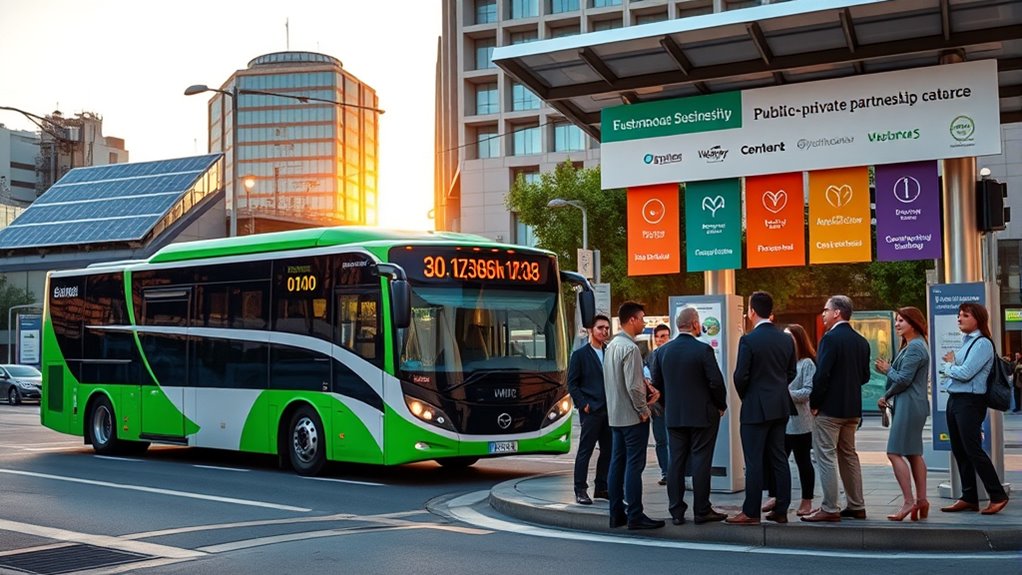
Financial approaches play an essential role in enabling successful public-private partnerships (PPPs) for electric bus deployment. Government funding, like India’s FAME scheme, allocates billions to support e-bus adoption, bridging cost gaps through grants and concessional capital. Payment guarantees under GCC projects improve bankability, while viability gap funding isolates capital risks from long-term operations. Utilization of data-driven marketing strategies can help promote these projects to attract further private sector interest and investment. Utility-bill financing models recover infrastructure costs via service charges. Financial intermediaries, such as dedicated bus-sector financing corporations and development finance institutions, attract investments through blended capital and low-cost debt. Lease models like Battery-as-a-Service and operational leases transfer ownership and depreciation risks, making procurement attractive. Risk mitigation strategies, including long-term PPAs and revenue-sharing, stabilize costs. Incorporating partnership dynamics can further enhance project sustainability by fostering trust and collaboration among stakeholders. These financial approaches create a solid foundation for scalable, sustainable e-bus PPP projects.
Future Directions and Emerging Trends in E-Bus PPPs
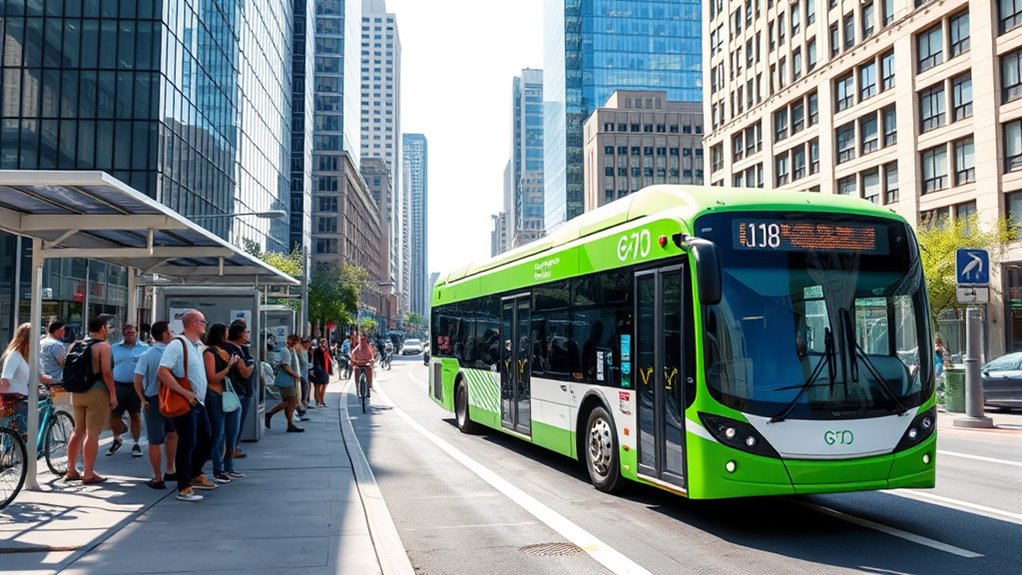
As electric bus adoption accelerates, future trends are shaping how public-private partnerships (PPPs) will evolve to meet emerging urban mobility needs. You’ll see a focus on expanding on-route charging with dynamic, interoperable systems and modular stations, partnering with utilities to upgrade grids and pilot wireless charging at stops.
Battery tech will improve with higher-density energy, AI-driven management, fast-charging, and second-life applications. Additionally, innovations in battery recycling will be crucial for sustainable lifecycle management of electric bus batteries, reducing environmental impact and supporting circular economy goals. These advancements will also require advanced recycling processes to efficiently recover valuable materials and minimize waste.
Advances in battery tech will boost energy density, enable AI management, support fast-charging, and promote second-life applications.
Policy reforms will streamline permits, standardize contracts, and create incentives tied to emissions and efficiency goals.
Grid integration will feature microgrids, vehicle-to-grid systems, and smart charging aligned with renewable energy sources.
Autonomous e-buses with self-charging, centralized management platforms, and predictive maintenance will enhance operational efficiency.
Additionally, remote hackathons can foster innovative solutions for smart charging infrastructure and grid integration challenges, promoting collaboration among diverse stakeholders.
These innovations will help PPPs deliver cleaner, smarter, and more reliable urban transit solutions.
Frequently Asked Questions
How Do PPPS Influence the Long-Term Sustainability of E-Bus Projects?
PPPs influence the long-term sustainability of e-bus projects by sharing financial risks, reducing upfront costs, and attracting private sector investment. They promote innovative solutions, expand charging infrastructure, and upgrade power grids to meet future demands.
You benefit from cost savings and environmentally friendly transport options, while collaboration guarantees ongoing technological advancements and policy support.
These combined efforts create resilient, adaptable systems that contribute to cleaner, sustainable urban transportation over time.
What Role Do Local Communities Play in E-Bus PPP Initiatives?
Ever wondered how communities shape electric bus projects? You play a crucial role by providing local insights, participating in decision-making, and advocating for equitable benefits. Your involvement in workshops and feedback channels helps tailor infrastructure to community needs, guaranteeing projects address local pollution and economic concerns.
How Are Risks Typically Shared Between Public and Private Partners?
In risk sharing, you’ll find that private partners usually take on upfront costs like vehicle and infrastructure investments, while public entities provide subsidies and grants.
You’ll also see revenue-sharing models and long-term payment structures to balance demand risks.
Additionally, private firms handle operational risks such as maintenance and technology updates, while public agencies manage regulatory and political risks.
Together, this division helps mitigate uncertainties and promotes successful electric bus deployment.
What Are the Main Barriers to Private Sector Participation in E-Bus PPPS?
You face several barriers when participating in e-bus PPPs. High upfront costs and limited access to financing make it tough to justify investments.
Inadequate regulations and complex permitting delay projects, while technological risks and supply chain issues add uncertainty.
Market volatility and competition also threaten profitability.
Without clear policies, supportive infrastructure, and risk-sharing mechanisms, private sector involvement remains challenging, hindering the expansion of electric bus services.
How Can Policy Reforms Accelerate E-Bus Adoption Through PPPS?
You see, policy reforms can be game-changers. By tightening emission standards and offering upfront incentives, you make electric buses more attractive to private partners.
When you streamline regulations and provide infrastructure support, you reduce risks and costs. These changes create a smoother path for PPPs, accelerating adoption.
Combining financial tools like grants and guarantees with capacity-building initiatives guarantees the private sector is motivated, prepared, and empowered to deploy e-buses faster.
Conclusion
By embracing public-private partnerships, you become the captain steering the ship toward a cleaner, sustainable future. These collaborations are the lighthouse guiding e-bus projects through stormy challenges, illuminating paths to innovation and growth. As you navigate this journey together, remember that each partnership is a seed—planted today, it blossoms into a vibrant, greener tomorrow. Your role is essential in transforming the urban landscape into a thriving, eco-friendly horizon.
